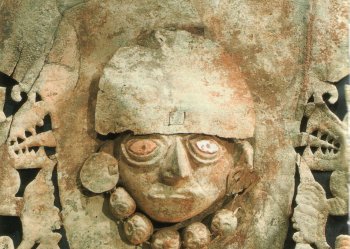
The True Sun of the Incas
Part 2
This article follows on from "The True Sun Part 1" (1)
Other anomalous finds from Peru add fuel to this celestial fire. Kathy Doore is a researcher who has travelled to Peru many times in connection with the Ica Stones (2). Some time ago she sent me some images of an example of an Ica Stone that appeared to show anomalous celestial phenomena that could well be related to a previous appearance of Nibiru. If these carved river stones are authentic in displaying the artwork of an ancient people inhabiting the lands of Peru, then this is certainly strong evidence. But I was cautious initially, because other Ica Stones (and there are literally tens of thousands of them) show dinosaurs and such like. It all seemed a little far-fetched.

[This image shows an Andean silver headdress said to depict a 'warrior flanked by two dragons' (5). Note the 7 discs creating a necklace around the warrior's neck (the one to the far right is damaged). If one takes the dragons to be fiery wings flanking a central disc (and the warrior's face is clearly spherical) then we can see the classic Winged Disc imagery emerge here. This is Dark Star symbolism - made all the more poignant by the inclusion of the seven discs; showing the seven orbiting moons, two of which are major, five minor. The two major moon discs correspond to the uraei of the Egyptian Winged Discs.]
The primary investigator of the Ica Stones was the late Dr Javier Cabrera. He set about trying to collect, catalogue and analyse patterns among the Stones, obtaining them for practically nothing from Peruvians who claimed that they had excavated them. Archaeological digs must be permitted officially in Peru, and this led to certain problems of authenticating the finds when the Peruvian media became involved: some of the people who were original sources of the Ica Stones changed their stories when pressed by the authorities and claimed to have created the tens of thousands of stones over the course of several years.
The matter of the Ica Stones had already been dismissed by academic archaeologists in general, and now was firmly debunked by the media. Despite this, there remains a fascination for them. This is probably because the accusation of ‘fraud’ flies in the face of common sense. There are up to 50,000 of these stones in private collections around the globe; the process of creating them would have amounted to an industrial scale output. Yet they have always been worth next to nothing individually, and for many years languished in rubbish piles in the Ica museum. Furthermore, there was scientific evidence to suggest that the engravings were indeed old, and certainly not contemporary, as the frustrated Dr Cabrera explained:
“On January 28, 1969 I received word from Eric Wolf that the results of the laboratory analysis conducted by a Professor Frenchen and his assistants at the University of Bonn were available. The stones were andesite and were covered by a patina or film of natural oxidation which also covered the etchings, permitting one to deduce that they are very old.
“In view of the fact that the patina of oxidation that covered the stones proved the general but not precise antiquity of the engravings, and in view of the fact that precision could only be had by using the comparative methods of stratigraphy and paleontology, I requested authorization in April 1970 from the Patronato Nacionial de Arqueologia to carry out excavations in the appropriate zone. This institution alone had the power to authorize such excavations. On July 16, 1970, my request was refused. Thus the only means of dating the Engraved Stones of Ica was closed to me.” (2)
In addition, several Ica Stones were discovered in unearthed tombs in the Ica region by archeologists in the 1960s, self-evidently authenticating these particular stones and bringing into question the almost universal dismissal of the Ica Stones in general:
“In 1968, the archeologist Pezzia Assereto, who had accompanied Agurto Calvo, published a book on the archeology of the province of Ica, in which he makes note of the discovery: "Agurto was able after several attempts to find an engraved stone inside a tomb in the sector of Toma Luz of the Hacienda Callango del Valle in Ica on 20 August 1966... After informing the Museo Regional of Ica of such an important find, Agurto and I made another excavation on 11 September of the same year, in the hill called Uhle of the sector of La Banda in the Hacienda Ocucaje, and we found for the first time an engraved stone inside a tomb of the Paracas culture, a thing I was not expecting, but which proved, by association, the authenticity of these artifacts"” (2)
Even so, things are rarely black and white. It is entirely possible that even if there are original, ancient Ica Stones dug out of the ground or found in tombs, there may also be a large body of faked Stones created by some of the locals hoping to cash in on the find. In which case, how does one determine which of them are genuine and which are faked, and how does one draw any firm conclusions from the body of Stones as a whole? A similar predicament presents itself when assessing the Crop Circles prevalent each year in the English countryside; no one thinks they are all ‘genuine’, but some researchers consider it likely that some crop circles are truly anomalous. This complex picture seems plausible, so we must tread carefully when similarly considering the Ica Stones.
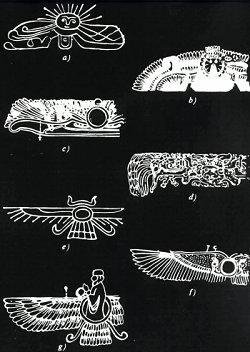
Comparing Winged Discs from around the Globe (8):
a) South American; b) Toltec; c) Aztec; d) Mayan; e) Babylonian; f) Egyptian; g) Iranian
If entirely genuine, the Ica Stones present a massive body of ancient scientific knowledge in the realms of astronomy, medicine, cartography, biology, and technology and natural history. So it is little wonder that the authenticity of these myriad stones has been called into question. Dr Cabrera’s most explosive claim was that depictions showing men alongside dinosaurs indicated that the stones emanated from the very remote past, and that mankind lived during the era of the dinosaurs. This rather incredulous claim probably banged a few more nails into the coffin of the Ica Stones; it certainly would not have endeared his efforts to academia.
Yet others have also suggested such a possibility. For example, on the fossilised bed of the Paluxy River in Texas the so-called ‘Taylor Trail’ of human footprints is crossed over by prints of a three-toes dinosaur. The ancient rock at this site is dated to over 100 million years (3). Fossilised footprints have been discovered in deep mines, indicating human antiquity well beyond the current estimates. Conversely, other relics from the ancient past, like the 5000 year old Egyptian ‘Palette of Narmer’ seem to show dinosaurs interacting with people (3).
This area of research is a fascinating one, though somewhat beyond the scope of this essay. However, I think one should be careful about assuming that a body of knowledge of dinosaurs among ancient peoples might indicate either remote human existence or the contemporary anomalous existence of such ‘live’ creatures. There is another possibility.
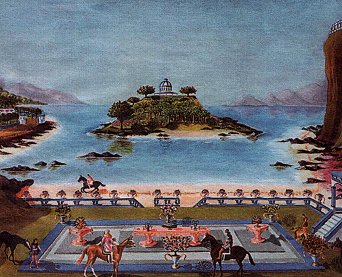
The supposed existence of a destroyed civilisation pre-dating Egypt and Sumer falls into two categories: the fabled existence of Atlantis, as described by Plato, and the intervention of space-faring gods, or ‘ancient astronauts’.
Both schools of thought have a spectrum of advocates, (and many detractors), and both theories call for advanced technology and scientific knowledge among a lost ancient people in both cases.
Traces of that knowledge are thought to have passed down by oral tradition, anomalous material evidence and through the careful and detailed construction of ancient monuments.
It seems eminently plausible to me that a working scientific knowledge of remote Natural History of our Earth would have been understood by either Atlanteans or, even more likely, the Anunnaki. In the case of the latter, the Anunnaki are described as having a keen interest in mining for gold (4), beginning in Africa and probably extending to South America. It does not seem beyond the realm of possibility that dinosaur bones were excavated, studied and perhaps collected.
Thus, a technologically advanced race of humans in antiquity may have known of the dinosaurs, and that knowledge may have filtered down to ancient peoples after the Cataclysm through dragon-based myths and the like.
Perhaps, then, the Ica Stones were created by ancient Peruvian peoples based upon an inherited knowledge of the Earth’s Natural History. We could then rule out the existence of dinosaurs still roaming the Earth in living memory (which seems unlikely, although not entirely impossible) and the idea, promulgated unsuccessfully by Dr Cabrera, that the Ica Stones stand as a unique testament to the very remote existence of humanity many millions of years ago.
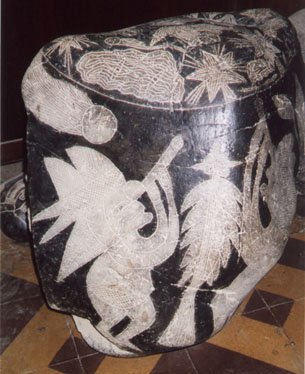
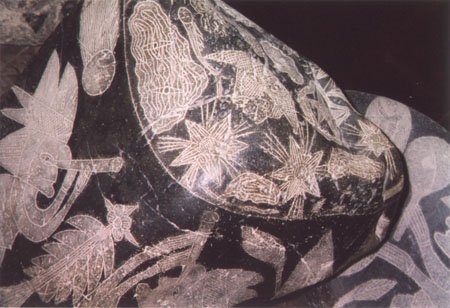
So what of the particular above? If they are genuine, ancient Ica Stones created by the indigenous people of Peru hundreds, possibly thousands of years ago, then do they point to the existence of the ‘True Sun of the Incas’? This Ica Stone has several fascinating features. Firstly, the Andeans pictured appear to be looking up at the heavens using telescopes. One would imagine this to be utterly impossible for the ancient Incas; a certain mark of fakery surely?
Well, things are never quite as straightforward as they first appear. Robert Temple, the author of 'The Sirius Mystery', wrote a book about the unrecognised collections of ancient lenses in various museum collections around the world, entitled 'The Crystal Sun' (6). The lenses had been discovered by archeologists for generations and dutifully handed over to disinterested antiquarians for display in various museums. His book makes a strong case for the widespread use of lens in the ancient world, and even proposes the use of telescopes, as can be seen from the shard of Greek pottery that adorns the front cover of his book.
Temple does not describe examples from South America, but there are famous examples of worked rock crystal from Meso-America. I have in mind, of course, the Mitchell-Hedges Crystal Skulls.
It is not a big leap from these incredible artifacts to working rock crystal into lenses to be used by the Incas, and thus featuring on an Ica Stone.
Furthermore, tantalising evidence for the existence of ancient lenses in South America is recorded by Harold T. Wilkins in 1945. Wilkins was born in 1891 in my own home city of Gloucester, and may even have attended the same grammar school there. During his extensive researches in South America before World War II he met Seňor Muňoz, a haciendero who owned an estate on the seashore not far from Guayaquil, Equador. Harold Wilkins relates this remarkable tale, alluding to the possibility of the finds being linked to a lost continent in the Pacific Ocean:
“He [Seňor Muňoz] set a diver to fish up statuettes from a drowned and very ancient city lying under water just off shore. The diver came up with artistic statuettes of men and women whose hair was dressed in very Egyptian fashion! They had the same curiously long slanted eyes as you find in frescoes in the tombs of the Pharoahs. On their breasts were jewels carved in stone. The dead and ancient civilisation must have been very, very old; for some of the statuettes are pornographic – a sign that the makers are of a race that has lapsed from a higher state of culture.
“As said Muňoz to me: “Seňor Wilkins, it may amaze you to hear that every race in the world is represented in these statuettes, so incredibly ancient, found under water by my diver. There are Aryans, Semites, Caucasians, and even a race remarkably like the modern Japanese! The race had seals like prisms, covered with hieroglyphs. Also, I have found ancient convex lenses, under water, there, and also reflectors. They were made of obsidian…they must have been scientific opticians, even astronomers.”” (7)
So perhaps we would do well to keep an open mind on the potential for ancient optical technology in the Andes. Of course, this is not the only remarkable feature of Kathy's Ica Stone. The centre-point of the heavens pictured on the stone is an odd-shaped feature, not unlike an upturned boat! Perhaps a celestial barge, like the ones often featured by the ancient Egyptians? This celestial barge is accompanied by clouds, meteors and stars. Additionally, below the celestial canopy is a huge comet.
But note that the Andeans are not pointing their telescopes at the great comet, as one might expect. Instead, they are looking at that celestial barge. So I wonder whether the 'celestial barge' is the return of the Dark Star Nibiru, surrounded by its halos and companion 'stars' (really moons). If so, then telescopes are evidently required to see the heavenly apparition, which is itself interesting. A point I shall pursue in my new book 'Binary Companion', (which I hope to finish one of these days...) The lower and rather prominent 'comet', or sizeable meteor, is perhaps a sign of danger; the potential for a catastrophe associated with the return of Nibiru.
Perhaps this is portending the end of an Age when the 'True Sun' returns?
Of course, this all rather depends upon the authenticity of the Ica Stones in the first place, and this is not a question that will be answered soon, if ever. Archeologists have no interest in these stones whatsoever, having assumed from the start that they must be fake. But the context of this particular Ica Stone is certainly consistent with a body of evidence about the Dark Star, the 'True Sun', that is continuing to build from various sources, both mythological and scientific.
A Peruvian Binary Circle
Greg Jenner has come across an example of a binary sun circle at Sillustani in Peru that presumably pre-dates the Incas. The circles are of unequal size with the largest circumscribed by a platform of hewn stones.
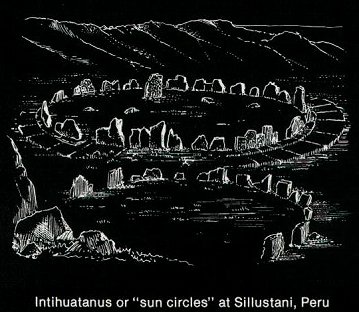
This larger circle also has a single upright stone placed within it, as described in an account by E.G. Squier in 'American Naturalist (1870):
"In
connection with the group of chulpas at Sillustani, or rather on the same
promontory on which these occur, are found a number of such Sun-circles, which
seem strangely to have escaped the notice of travellers. The tradition of their
original purpose is preserved in the Quichun name they still bear of Intihuatana,
'where the sun is tied up'.
"Some of these circles are more elaborate than others, as shown in the
engraving, from which it will be seen that while the one nearest the spectator
is constructed of simple upright stones, set in the ground; the second one is
surrounded by a platform of stones more or less hewn and fitted together. The
first circle is about 90' in diameter; the second about 150', and has a single
erect stone standing in the relative position I have already indicated. A
remarkable feature in the larger circle is a groove cut in the platform around
it, deep enough to receive a ship's cable." (9)
It seems peculiar that there should be 2 suns denoted by these circles. If this is an example of an early observatory, like Stonehenge in England or the Medicine Wheels of North America, then one would expect a single circle, with the interior standing stone acting as a viewing marker.
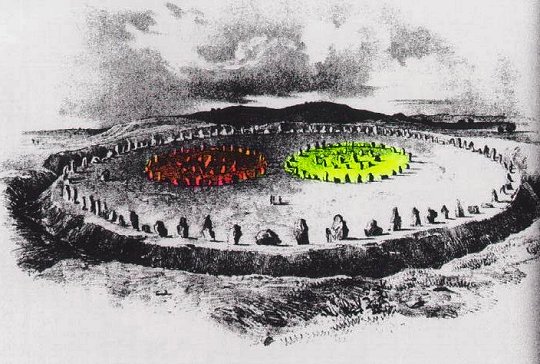
Two circles logically imply two suns; a binary star system that was understood by the ancient Peruvians. Remarkably, a similar binary solar circle can be found at Avebury in England (see above). I have scant information about these standing stones, but it seems logical that the single stone within the larger circle is an archeo-astronomical marker of some kind. However, a further possibility exists.
In a binary system the centre of gravity of the solar system would be shifted away from the exact centre of the Sun. Does this stone provide an approximate location for the centre of the solar system, thus enabling us to ascertain the approximate whereabouts of a sub-brown dwarf companion? Whether or not this is the case, the fact that such a binary solar circle exists in Peru is further supportive evidence that the ancient people of this area maintained a tradition of knowledge that is now, perhaps, lost: a secret knowledge of Nibiru.
40,000 year old Footprints in the Americas
The generally accepted position regarding the early colonisation of the Americas is that settlers crossed the Bering Strait Land-bridge some 12,500 years ago. This was towards the end of the last Ice Age when oceanic waters were lower than now, due to the amount of global water tied up in the ice caps and continental glaciers. A land-bridge across the Bering Strait dividing Asia and North America is known to have been exposed continuously from about 35,000 years ago until 11,000 years ago, and intermittently during the period before that (10). The evidence for the migration of settlers from Asia across this land-bridge is extensive for the period around 12,500 years ago.
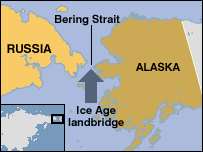
It stems from tools which have been discovered that were used to hunt the massive prehistoric animals indigenous to the Americas during that period, such as mammoth and mastodons. The theory built up from this evidence is known as "Clovis First".
More controversial is the idea that humans may have discovered the Americas long before this time. There is some scientific evidence suggestive of this scenario (11), but each find has been heavily criticised by prominent scientists in the field. Alternative theorists point to a pattern of evidence which suggests that the mainstream scientists may be wrong to debunk such findings (3). An argument has raged for decades over this issue, with people like Graham Hancock heading the vanguard of new thinking. The problem has been that there has been no 'smoking gun' to persuade the scientific establishment to accept an earlier presence of humans in the Americas. That is, perhaps, until now.
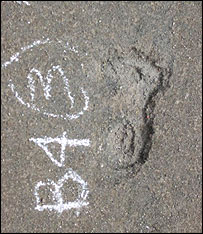
British scientists dating a series of fossilised human footprints discovered in a Mexican quarry have presented conclusions based on two years of careful work. They consider that their findings unambiguously point to a period some 40,000 years ago for these footprints. This pre-dates current theory for a human presence in the Americas by almost 30,000 years! The findings are bound to provoke controversy, and the team expect to have their work carefully scrutinised by the scientific community. In fact, they expect a very rough ride.
"Scientist Silvia Gonzalez of Liverpool's John Moores University and her colleagues found the footprints in the quarry, some 130km (80 miles) south-east of Mexico, in 2003. But they have only finished dating them this year. The footprints were preserved as trace fossils in volcanic ash along what was the shoreline of an ancient volcanic lake," Dr Gonzalez said...The existence of 40,000-year-old human footprints in Mexico means that the Clovis First model of human occupation can no longer be accepted as the first evidence of human presence in the Americas," said co-investigator David Huddart, of Liverpool John Moores." (12)
The problem is that an earlier migration of humans around this time cannot rely on the existence of the Bering Strait Land-bridge.
The implication, then, is that humans were capable of travelling across the ocean 40,000 years ago. This is simply too much for most scientists to accept. Yet, we cannot allow theory to get in the ways of facts... If the Mexican footprints are indeed as old as is being suggested, then the ability of humans to travel across the Pacific Ocean 40,000 years ago needs to be considered.
Silvia Gonzalez has suggested that such a migration may have been assisted by the fact that lower sea levels would have exposed larger tracts of the many oceanic ridges, creating a more numerous network of larger Pacific islands.
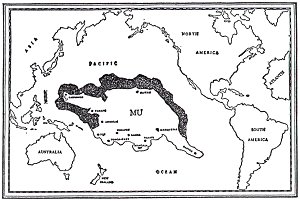
In a way, this concept reflects the esoteric understanding of the Lost Continent of Mu in the Pacific Ocean (13), which presumably 'sank' due to the rising sea levels at the end of the last Ice Age. Such a network of islands would assist the migration of peoples across the Pacific, although it would by no means act as a complete land-bridge. Large tracts of ocean would still require passage by boat, implying a technology available to prehistoric man that simply does not fit with the current scientific model. One can begin to see why there has always been a dogmatic knee-jerk reaction to debunk any evidence suggestive of very early human presence in the Americas.
I would like to point out two things here. Firstly, human being have been biologically quite static for about 100,000 years. In other words, people living 100,000 years ago were just like us! Given the ability of our species to harness our environment, it seems probable to me that the ancient 'moderns' would have been capable of more than we give them credit for. The fact that the remains of ocean-going boats from 40,000 years ago have not been discovered means nothing.
Of course they have not been discovered! How could the wood have survived that long without the aid of fossilisation, which would be extremely unlikely given that the boats were kept, dare I say it, at sea! Simply put, any evidence of ancient technologies that wasn't built of stone would not have survived. The lack of evidence for non-stone artefacts does not negate their actual previous existence.
So, I would recommend an open mind hen considering the age of human settlement of the Americas. Common sense suggests that it is quite possible, as long as one isn't Bering Strait-jacketed by current theory!
Written by Andy Lloyd, 26th August 2004 & 12th January 2005, with thanks to Kathy Doore and Greg Jenner
author of 'The Dark Star' (2005), 'Ezekiel One' (2009), 'The Followers of Horus' (2010) and 'Darker Stars' (2018)
References
1) A. Lloyd "The True Sun Part 1" 15 January 2004
2) K. Doore (Ed); ‘Excerpts from “The Message of the Engraved Stones of Ica” by Javier Cabrera’
3) Michael Baigent “Ancient Traces” pp18-20, Penguin 1998
4) Z. Sitchin “The Twelfth Planet” Avon 1976
5) A. Cotterell (Ed) "Encyclopedia of World Mythology" PP294-9 Parragon 1999
![]() The Ultimate Encyclopedia of Mythology
The Ultimate Encyclopedia of Mythology
6) Robert Temple "The Crystal Sun" Century 2000
7) Harold T. Wilkins “Mysteries of Ancient South America” pp19-20, Rider & Co, London 1945
![]() Mysteries Of Ancient South America
Mysteries Of Ancient South America
8) Zoltan Simon ‘Atlantis: The Seven Seals.’ Robinson Expeditions Publishing, Vancouver, B.C. 1983
9) "The Primeval Monuments of Peru compared with those in other parts of the World". Squier, E.G., American Naturalist, 4:1-17, 1870 (from William R. Corliss' book "Ancient Man: A Handbook of Puzzling Artifacts" 1978, p140)
10) K. Feder & M. Alan Park "Human Antiquity" 3rd Edition, p364, Mayfield, 1989
11) A. Bryan [Ed.] "Early Man in America from a Circum-Pacific Perspective" pp78-101, 1978
![]() Early man in America from a circum-pacific perspective
Early man in America from a circum-pacific perspective
12) Paul Rincon "Footprints of 'first Americans'" 5th July 2005
http://news.bbc.co.uk/1/hi/sci/tech/4650307.stm
13) James Churchward "The Lost Continent of Mu", Futura, originally published in 1926